Introduction to Mango Mochi
What is Mango Mochi? Origins and Cultural Significance
Mango mochi is a tropical twist on the classic Japanese wagashi—a traditional sweet that’s often enjoyed during tea ceremonies or festive occasions. At its core, mochi is a rice-based confection made from glutinous rice flour, known for its soft and stretchy texture. While mochi has existed for centuries in Japan and other parts of Asia, mango mochi adds a refreshing, fruity flair that reflects modern fusion cuisine.
Many say mango mochi likely found its way into popularity through Taiwanese street markets and Japanese confections adapting to local ingredients. The inclusion of mango—ripe, golden, and full of summer vibes—has made it a standout in both Asian and Western dessert circles.
For me, discovering mango mochi was like unlocking a new dessert dimension. It felt familiar yet new. Traditional yet tropical. And I knew right away it had a story worth sharing.
Table of Contents
Why Mango Mochi is Trending Worldwide
There’s something universally appealing about mango mochi. It’s gluten-free, often dairy-free, and fits right into the clean-label trend. Plus, its vibrant colors and bite-sized aesthetic make it an Instagram darling.
But beyond the visual charm, mango mochi is beloved for its satisfying chewiness paired with fresh mango’s natural sweetness. Health-conscious dessert lovers appreciate that it’s often made with fewer ingredients and can easily be adapted to suit vegan or low-sugar diets.
In countries like the USA, UK, Australia, and across Southeast Asia, mango mochi has seen a surge in demand. You’ll find it in trendy bakeries, Asian supermarkets, and even gourmet ice cream shops, often as frozen mango mochi balls.
And let me tell you, once you’ve had that first soft bite and the mango flavor floods in—there’s no going back.
Ingredients and Traditional Recipe Breakdown
Core Ingredients Used in Mango Mochi
If you’ve ever wondered what’s in mango mochi, you’re not alone. One of the things that drew me into this dessert—beyond its luscious flavor—was how few ingredients it actually takes to make. At its core, mango mochi is simplicity at its most delicious.
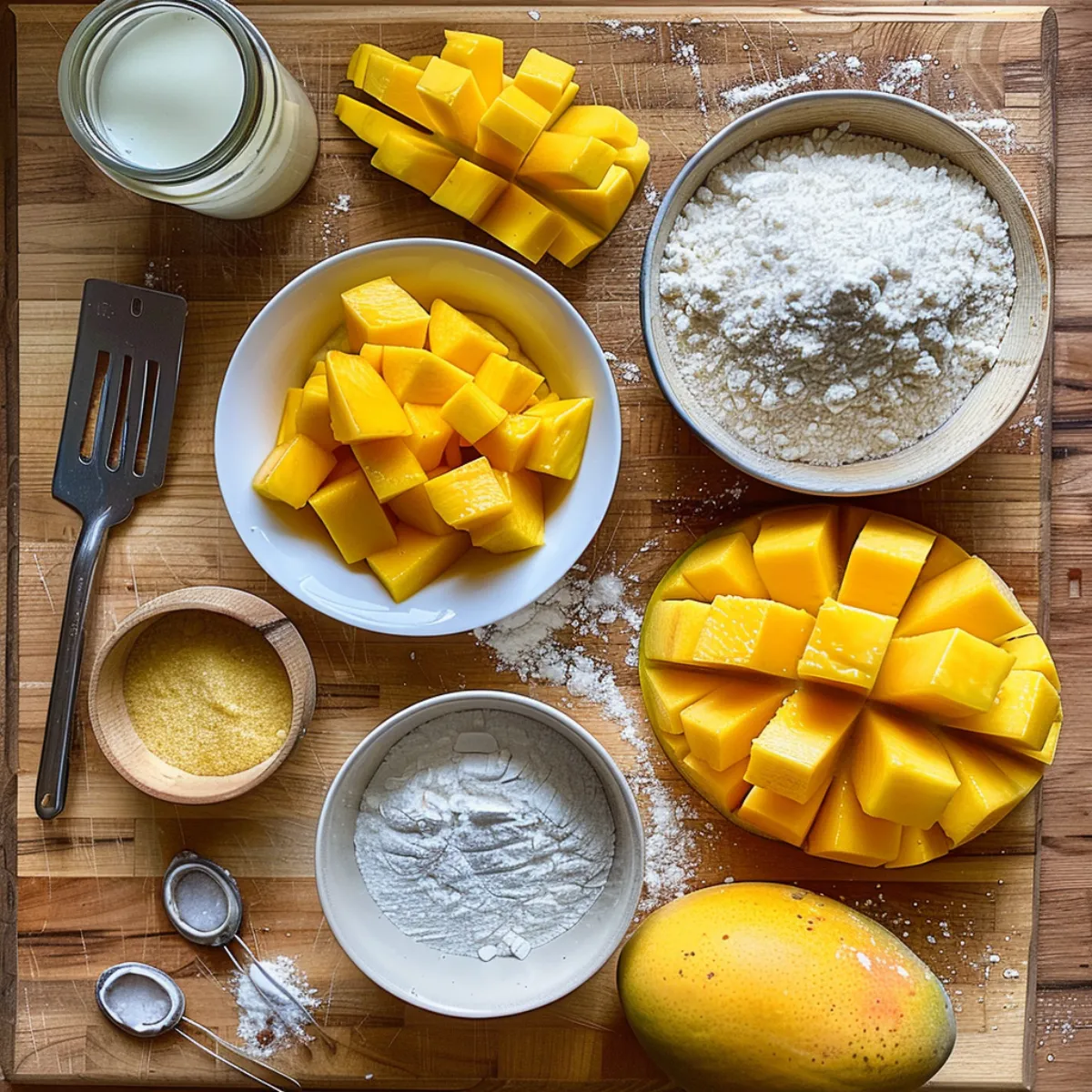
Here’s a breakdown of the essential ingredients:
| Ingredient | Purpose |
|---|---|
| Glutinous rice flour | Forms the stretchy, chewy mochi dough |
| Sugar | Adds sweetness to balance the mango |
| Water or coconut milk | Hydrates the flour, adds subtle richness |
| Cornstarch | Prevents sticking during shaping |
| Mango puree or chunks | Delivers the fruity, tropical flavor |
The foundation is glutinous rice flour, sometimes labeled “mochiko” or “sweet rice flour.” Don’t be fooled by the name—it’s gluten-free and has nothing to do with gluten from wheat. When cooked, this flour becomes delightfully elastic, which gives mochi its unique chew.
Then there’s fresh mango—the star of the show. Ripe Ataulfo or Alphonso mangoes are my go-to for their vibrant sweetness and smooth texture. You can use fresh purée or even finely chopped mango pieces depending on the texture you prefer inside the mochi.
A touch of sugar rounds out the flavor, and a bit of coconut milk instead of plain water adds richness and a tropical scent that complements mango beautifully.
How Each Ingredient Impacts Taste and Texture
Let’s talk about how each ingredient plays a role, because this isn’t just about throwing things together—mango mochi is a balance of textures and tastes.
- Glutinous rice flour: The hero of chewiness. Cook it too little, and your mochi will tear. Too long, and it becomes rubbery. But just right? Oh, that magical bounce.
- Mango: Brings freshness and tang. Pureeing it blends it seamlessly into the filling, while mango chunks offer bites of juicy contrast.
- Sugar: While mochi can be cloyingly sweet in some store-bought versions, homemade gives you full control. I recommend keeping it light to let the mango shine.
- Coconut milk or water: Adds moisture. Coconut milk adds creaminess, which enhances the tropical notes—perfect if you’re pairing it with island-inspired flavors.
- Cornstarch: This isn’t in the dough, but it’s essential. Without it, your mochi will stick to your fingers, your tools, and your sanity.
The harmony between these ingredients is what gives mango mochi its charm. It’s soft but firm, sweet but natural, exotic but approachable.
Step-by-Step Guide to Making Mango Mochi at Home
Tools and Prep Tips for Beginners
When I first tried making mango mochi in my tiny apartment kitchen, I was convinced it would be complicated. Spoiler alert: it wasn’t! You don’t need fancy tools—just a bit of patience and a love for hands-on desserts.
Here’s what you’ll need:
| Tool | Purpose |
|---|---|
| Microwave-safe bowl | For steaming the mochi dough |
| Silicone spatula | Stirring the sticky dough |
| Rolling pin (optional) | Flattening the dough |
| Plastic wrap/parchment | Rolling and storing individual mochi |
| Ice cream scoop | Measuring filling consistently |
| Steamer (optional) | Alternative to microwave for dough |
Pro Tips:
- Grease your spatula and hands lightly with oil to prevent sticking.
- Keep your mango chunks or purée chilled before filling—this makes the mochi easier to seal.
- Use cornstarch generously on your work surface, or else your mochi will glue itself to everything.
Cooking Process: From Dough to Delicious
Here’s my go-to recipe process for crafting mango mochi with a creamy, chewy texture.
1. Make the Dough
In a microwave-safe bowl, mix:
- 1 cup glutinous rice flour
- ¼ cup sugar
- ¾ cup water (or coconut milk for extra flavor)
Stir until smooth. Cover loosely with plastic wrap or a microwave cover.
Microwave on high for 1 minute. Stir. Microwave again for 1 more minute, stir, then one final 30-second blast. The dough should look translucent and stretchy.
If using a steamer, pour the mixture into a heat-safe dish and steam for about 20 minutes.
2. Prepare the Filling
While the dough cools slightly:
- Scoop fresh mango purée into small balls and freeze for 10–15 minutes.
This firms them up, making assembly easier.
You can also use mango ice cream or frozen mango pieces for a cool twist.
3. Shape the Mochi
Dust your work surface with cornstarch. Once your dough is cool enough to handle but still warm:
- Scoop out a tablespoon of dough.
- Flatten it into a disc.
- Place a mango ball in the center and pinch the edges closed like a dumpling.
Roll gently between your palms to shape it into a ball.
4. Chill and Serve
Wrap each mochi in parchment or place in cupcake liners. Chill in the fridge for at least 30 minutes before serving. This helps the mochi set and makes the texture perfect.
Making mango mochi at home really brings out your inner food artist. Each piece is a little edible treasure—and trust me, once you get the hang of it, you’ll be looking for excuses to whip up a batch every week.
Flavor Profile – What Does Mango Mochi Taste Like?
Texture and Mouthfeel Explained
Let’s talk chew. The first thing you’ll notice when biting into mango mochi is its signature texture—a soft, stretchy exterior that gives way to a silky, fruity center. It’s like a plush pillow for your taste buds.
When I served mango mochi at a dinner party last summer, a friend described it perfectly: “It’s like biting into a cloud that surprises you with sunshine.” That chewy layer comes from the glutinous rice flour, creating a bounce that’s oddly satisfying. Unlike Western pastries or crispy snacks, mochi is about elasticity and cushion—a totally different sensory experience.
But it’s not just the outer shell doing the work. The inside matters too. The cool, juicy mango brings contrast—bright and refreshing against the gentle chew of the mochi. And if you freeze your filling before wrapping, you get an extra burst of cool creaminess with every bite.
This combination of springy outside and smooth, chilled inside is what makes mango mochi so addictive. It’s not just dessert—it’s a sensory adventure.
The Sweet, Tangy, and Creamy Balance of Mango
So, what does mango mochi taste like? In one word: balance.
The sweetness is natural and fruit-driven, especially if you’re using ripe Ataulfo or Alphonso mangoes. These varieties are honey-sweet with floral undertones that really shine through the mild, starchy mochi shell.
Depending on your recipe, you might also get:
- Coconut notes (if you use coconut milk)
- Citrusy brightness (with a dash of lemon or lime)
- Creamy undertones (if frozen mango or mango ice cream is used)
The overall flavor is light but impactful. It’s sweet without being cloying, tangy without overpowering, and creamy without heaviness.
I once experimented by adding a pinch of sea salt on top. The result? A contrast that elevated the mango’s natural sweetness and brought out hidden layers of flavor. Highly recommend it.
Whether you serve it fresh or frozen, mango mochi leaves a lingering taste of summer, sunshine, and joy.
Health Aspects of Mango Mochi
Is Mango Mochi Healthy? Nutritional Facts
Whenever someone asks me, “How healthy is mochi?” my answer is: it depends on what you put into it. And mango mochi? It’s surprisingly one of the lighter, more mindful desserts out there—especially when homemade.
Let’s break it down with some average nutrition facts for one piece of mango mochi (approx. 50g):
| Nutrient | Amount (approx.) |
|---|---|
| Calories | 120–150 kcal |
| Total Fat | 1–3g |
| Carbohydrates | 28–32g |
| Sugars | 10–15g |
| Protein | <1g |
| Gluten-Free? | |
| Dairy-Free? | (if no milk used) |
This means it’s a great option if you’re craving something sweet without going overboard. Compared to traditional cakes or creamy desserts, mango mochi is lower in fat and can be portion-controlled with ease.
Plus, when you make it at home, you have total control over:
- Sugar levels – Reduce or use alternatives like honey or maple syrup.
- Type of mango – Fresh over frozen for better nutrients.
- Milk base – Go dairy-free with coconut or almond milk.
And let’s not forget—mango itself is rich in vitamin C, antioxidants, and fiber, making this treat a dessert with benefits.
Gluten-Free and Dairy-Free Benefits of Mochi
One of the reasons I turn to mochi when serving guests is its diet-friendly nature. Many of my friends are gluten-sensitive or lactose-intolerant, and mango mochi always saves the day.
Here’s why:
- Gluten-Free: Made with glutinous rice flour, not wheat. Despite the name, there’s zero gluten involved.
- Naturally Dairy-Free: Unless you add milk-based creams, the standard recipe uses water or plant-based milks.
This makes mango mochi ideal for a variety of dietary needs. Whether you’re following a vegan lifestyle, cutting back on processed foods, or simply trying to eat cleaner, mochi fits right in.
But let’s keep it honest. While mango mochi can be healthy, it still contains sugar and starch—so moderation matters. Think of it as a joyful, mindful indulgence. And honestly, we all deserve that.
PART 6: Variations and Modern Twists on Mango Mochi
Frozen Mango Mochi vs Fresh
One of the most fun discoveries I had while playing around in my kitchen was realizing how versatile mango mochi can be. You’re not stuck with one version—there are multiple ways to enjoy it, especially when it comes to frozen vs fresh styles.
Fresh mango mochi is what we’ve been talking about so far: soft, chewy dough wrapped around juicy mango chunks or purée, served chilled. It’s light, fragrant, and perfect for warm afternoons.
But then there’s the frozen variety—and oh, it’s a game changer.
Here’s how they compare:
| Feature | Fresh Mango Mochi | Frozen Mango Mochi |
|---|---|---|
| Texture | Soft, chewy, room temp or chilled | Firm outer shell, creamy cold center |
| Flavor | Light and fruity | Intensified mango creaminess |
| Shelf Life | 1–2 days | Up to a week (in freezer) |
| Serving Experience | Delicate and tender | Refreshing, like ice cream mochi |
Frozen mango mochi is often filled with mango ice cream or frozen purée, creating a dreamy contrast of warm chewiness and cold creaminess. It’s also a great option for prepping ahead—just pull them from the freezer when you’re ready to wow your guests.
Tip: Let frozen mango mochi sit at room temp for 3–5 minutes before serving. That’s the sweet spot where the texture becomes perfectly chewy and the center creamy.
Infusions: Coconut, Matcha, and More
Once you get the hang of classic mango mochi, it’s impossible not to get creative. I’ve gone down that road many times, and every twist adds something exciting.
Here are some flavorful spins to try:
- Coconut Mango Mochi: Replace water with coconut milk and add shredded coconut to the dough. Think tropical vacation in a bite.
- Matcha Mango Mochi: Add ½ tsp of matcha powder to the mochi dough for an earthy, green tea contrast to the sweet mango.
- Ube Mango Mochi: Mix ube halaya into the dough for a colorful, nutty twist—purple and gold are stunning together.
Feeling experimental? You can even use flavored oils, fruit powders, or herbal infusions in the dough. Just make sure your base stays pliable.
These variations are more than just fun—they’re a reflection of how mochi continues to evolve across cultures and kitchens. That’s what makes mango mochi so endlessly inspiring.
Serving Suggestions and Pairings
When and How to Serve Mango Mochi
One of the joys of making mango mochi is discovering all the ways it can fit into your life. Whether it’s a quiet evening snack or the centerpiece of a dinner party spread, mango mochi shines in any setting. I’ve served it chilled on a hot summer afternoon, plated it with flair during a holiday dinner, and even wrapped a few pieces as a sweet homemade gift.
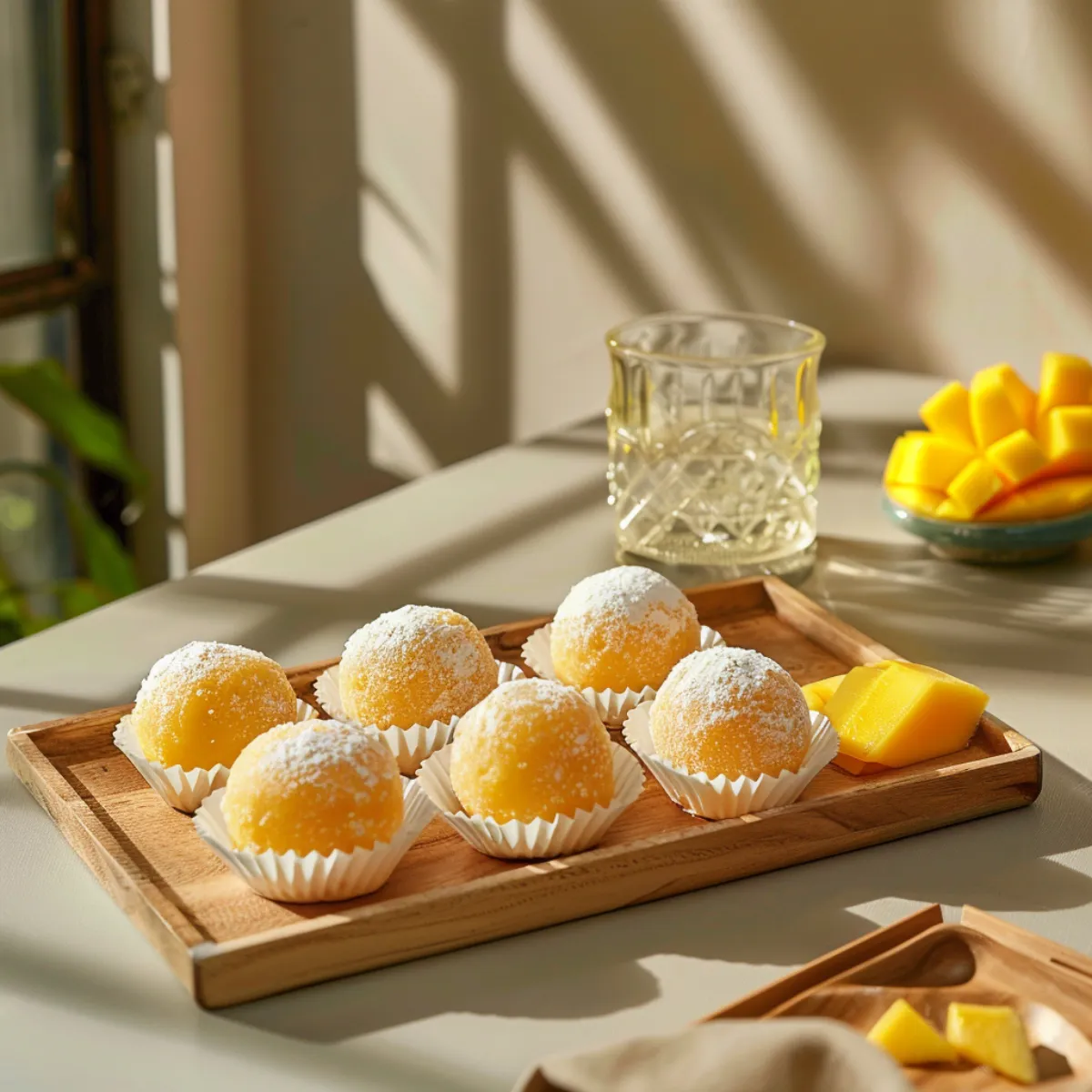
Here are a few ideal moments to serve mango mochi:
- Afternoon tea: Offer alongside green tea or jasmine tea for a relaxing bite.
- After-dinner dessert: Light and satisfying, especially after a rich meal.
- Party platter: Add to a dessert charcuterie board with tropical fruits and chocolates.
- On-the-go treat: Wrap individually and chill—perfect for road trips or lunchboxes.
Pro Serving Tip: Dust lightly with powdered sugar or garnish with toasted coconut for extra flavor and texture.
If you’re making frozen mango mochi, serve them in cupcake liners to help catch melting drips and keep fingers clean. For fresh versions, I love using little ceramic plates or banana leaves for a pretty, rustic look.
Best Drinks and Side Dishes to Accompany It
Pairing mango mochi with the right drink or side turns a good dessert into a great experience. Because mango mochi is subtly sweet with tropical notes, it pairs best with refreshing, light flavors.
Here are my top pairings:
| Drink | Why It Works |
|---|---|
| Iced green tea | Cleanses the palate, highlights mochi’s sweetness |
| Thai milk tea | Creamy richness balances the light mango flavor |
| Coconut water or lime soda | Enhances the tropical elements |
| Mango lassi | Double mango? Yes, please. Smooth and satisfying |
And for side dishes:
| Side Dish | How It Complements |
|---|---|
| Sticky coconut rice | Matches the texture and adds richness |
| Mango or pineapple sorbet | Amplifies fruity freshness |
| Chocolate-dipped fruit | Adds depth with a bitter-sweet contrast |
I’ve even hosted mochi tasting nights where I served multiple flavors—mango, matcha, and ube—and paired each with a different tea or fruit wine. It was a hit, and a wonderful way to introduce friends to something new and memorable.
PART 8: Where to Buy Mango Mochi or Find Authentic Recipes
Top Stores and Online Places to Get Mango Mochi
Not everyone has the time to make mango mochi from scratch—and that’s totally fine. When I’m short on time or just want to treat myself without the effort, I head straight to my favorite stores or browse online for trusted mochi brands.
Here are some top picks where I’ve found delicious mango mochi:
| Retailer | Why I Love It |
|---|---|
| Trader Joe’s | Their frozen mango mochi is creamy and budget-friendly |
| H Mart & Asian Markets | Fresh and frozen options, often made locally |
| Mochidoki (Online) | Gourmet mango mochi shipped straight to your door |
| Whole Foods | Carries clean-label brands with organic ingredients |
| Amazon | Great for shelf-stable or freeze-dried mochi snacks |
When shopping, always check the ingredients. The fewer, the better. And if you see preservatives or artificial flavors listed first—skip it. Trust me, the real thing tastes miles better.
If you’re lucky enough to live near a bakery specializing in Japanese or Taiwanese sweets, ask if they carry mango mochi. Many small shops make them fresh daily and often with unique twists like coconut mango or mango cheese fillings.
Recipe Roundup: Explore More Mochi Ideas
If you’re ready to dive deeper into mochi-making—or just want to keep experimenting with flavor—here are some must-try dessert recipes I’ve explored or bookmarked:
And if you’re feeling ambitious, experiment with your own mango mochi fusion flavors. Mango and raspberry? Mango and mint? The possibilities are endless when you treat food as both art and joy.
Looking for inspiration? Try exploring https://heartlyrecipes.com/recipes/ to see a full list of comforting, crowd-pleasing ideas from my kitchen to yours.
Now that we’ve journeyed through taste, texture, and technique—it’s time to answer the most common questions people ask about this magical dessert.
Frequently Asked Questions About Mango Mochi
What is in mango mochi?
Mango mochi typically includes glutinous rice flour (also known as mochiko), sugar, water or coconut milk, cornstarch for dusting, and mango purée or chunks. Some recipes may add coconut cream, condensed milk, or even mango ice cream in the center for a frozen twist. The outer layer is chewy and subtly sweet, while the inside bursts with juicy mango flavor.
When I make it at home, I love blending fresh mango with a touch of lemon juice to enhance its brightness. You can also control the sweetness level when making it yourself—another reason homemade mango mochi is so satisfying.
How healthy is mochi?
Mochi, including mango mochi, can be a relatively healthy dessert option—especially when homemade. It’s naturally gluten-free and can be dairy-free, making it accessible to many people with dietary restrictions. A typical piece contains about 120–150 calories, low fat, and modest sugar, depending on the filling.
That said, mochi is dense in carbs due to the rice flour, and store-bought versions might include additives or preservatives. So enjoy it in moderation, and always check labels if you’re buying it ready-made.
What does mango mochi taste like?
Mango mochi tastes like a soft, chewy rice cake with a sweet-tart tropical mango center. It has a unique texture—bouncy and slightly sticky on the outside, creamy or fruity on the inside. The flavor is refreshing and lightly sweet, with mango taking center stage.
Some versions taste richer with coconut milk or mango ice cream in the filling. Others are fresher and fruitier with real mango chunks or purée. Either way, mango mochi is a harmonious blend of chew and chill that makes every bite unforgettable.
What is a mochi made of?
Traditional mochi is made of glutinous rice flour, water, and sugar. The dough is either steamed or microwaved until stretchy and pliable, then shaped and filled with a variety of ingredients—like red bean paste, matcha cream, or, in this case, mango.
For mango mochi, that core formula stays the same but with the added twist of a fruity filling. Depending on your taste, you can stuff it with mango jam, purée, chunks, or even mango-flavored cream.
Conclusion: Why Mango Mochi Deserves a Spot in Your Dessert Lineup
Mango mochi is more than just a treat—it’s a cultural fusion of texture, flavor, and joy that’s easy to love and surprisingly simple to make. Whether you prefer it fresh or frozen, classic or infused with coconut or matcha, mango mochi fits any season, mood, or occasion.
From its chewy, stretchy dough to that bright mango burst in every bite, this dessert has captured hearts across cultures—and definitely mine. It’s become a go-to recipe in my kitchen, not just because of how good it tastes, but because of the creativity it inspires.
If you’ve never made mango mochi before, I hope this guide gives you everything you need to dive in. And if you’re already a mochi lover, try new spins or serve it alongside your favorite drinks for a fresh twist.
Thanks for taking this sweet journey with me. Until next time—keep exploring, tasting, and creating in your kitchen!
For more behind-the-scenes bites, visit me on Facebook and Pinterest.
Print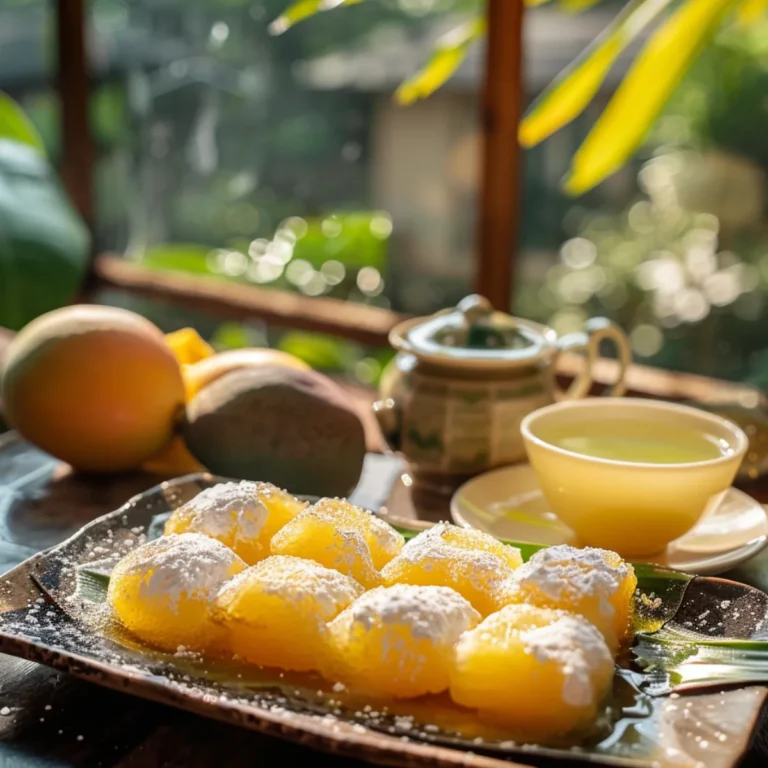
Mango Mochi: The Irresistible Tropical Treat You Need to Try
Mango mochi is a soft, chewy, and fruity Japanese-inspired treat, combining tropical mango flavor with traditional mochi dough. It’s naturally gluten-free and dairy-free, making it a crowd-pleasing dessert for all seasons.
- Total Time: 22 minutes
- Yield: 10 pieces
Ingredients
- 1 cup glutinous rice flour
- ¼ cup sugar
- ¾ cup water or coconut milk
- Fresh mango purée or chunks
- Cornstarch (for dusting)
Instructions
- In a microwave-safe bowl, mix glutinous rice flour, sugar, and water or coconut milk until smooth.
- Cover with plastic wrap and microwave for 1 minute. Stir, then microwave another 1 minute, stir again, and microwave a final 30 seconds until the dough is translucent and sticky.
- Let the dough cool slightly. Meanwhile, form small balls of mango purée and freeze for 10–15 minutes.
- Dust a surface with cornstarch. Scoop a tablespoon of mochi dough, flatten it, place a mango ball inside, and pinch to seal.
- Roll into a ball and chill each mochi for 30 minutes before serving.

Notes
Grease hands and tools to prevent sticking. Use ripe Ataulfo or Alphonso mangoes for the best flavor. Coconut milk adds richness and enhances the tropical taste.
- Prep Time: 20 minutes
- Cook Time: 2 minutes
- Category: Dessert
- Method: Microwave
- Cuisine: Asian Fusion
Nutrition
- Serving Size: 1 piece
- Calories: 130
- Sugar: 12g
- Sodium: 5mg
- Fat: 2g
- Saturated Fat: 1g
- Unsaturated Fat: 1g
- Trans Fat: 0g
- Carbohydrates: 30g
- Fiber: 1g
- Protein: 1g
- Cholesterol: 0mg
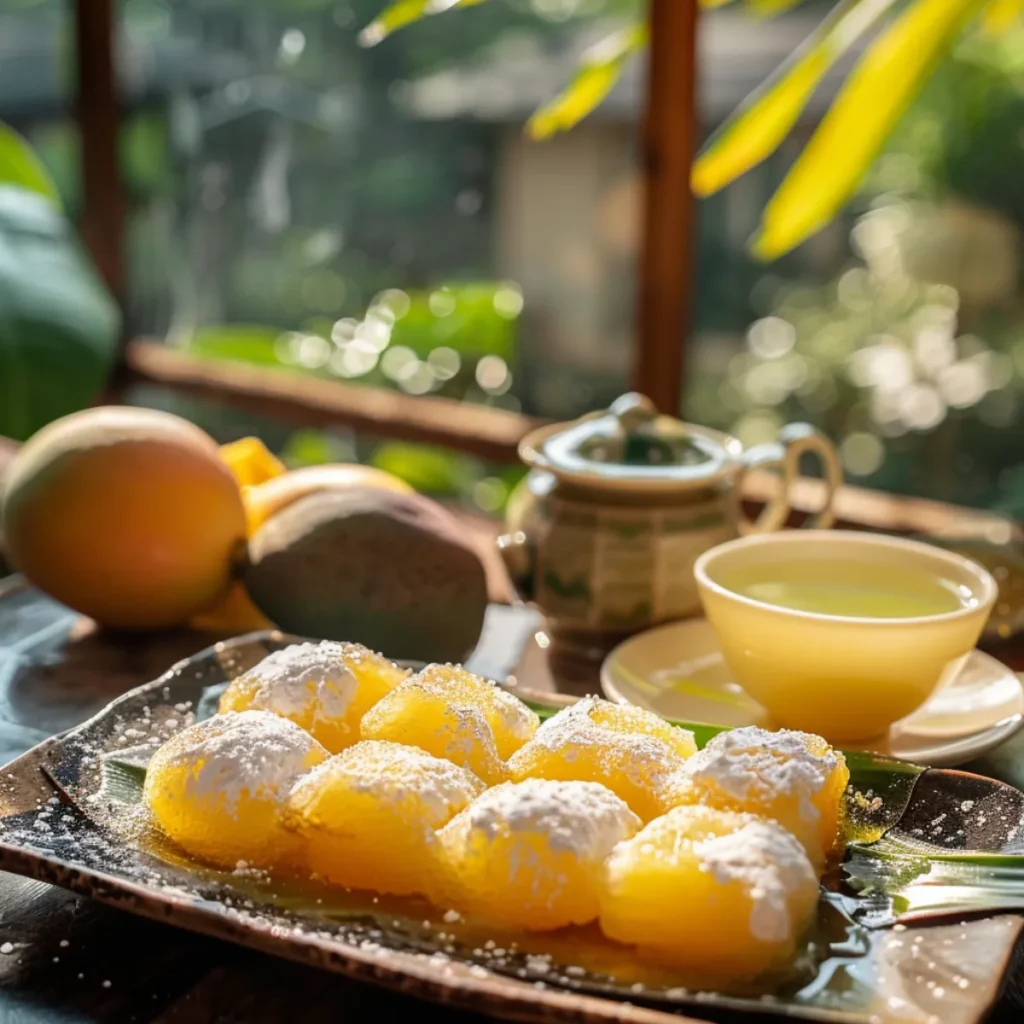

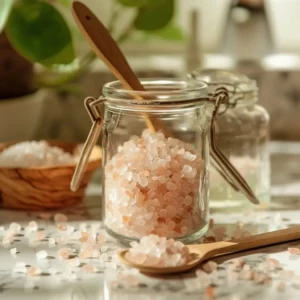
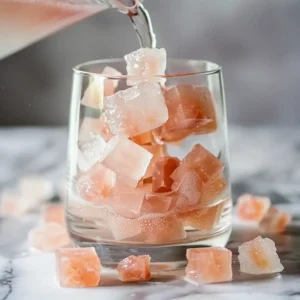




1 thought on “Mango Mochi: The Irresistible Tropical Treat You Need to Try”